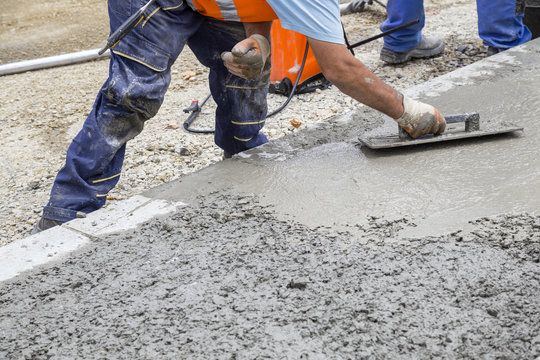Preparing the ground properly is the most crucial step in ensuring a durable, crack-free concrete slab. Whether you’re pouring a patio, driveway, shed foundation, or garage floor, the right preparation will determine the slab’s longevity and performance. Below is a detailed, step-by-step guide covering every aspect of ground preparation for a concrete slab.
Why Is Ground Preparation Important for a Concrete Slab?
Proper ground preparation ensures stability, prevents cracking, and provides a solid foundation for the concrete. Without a well-compacted, level base, the slab can settle unevenly, leading to structural issues, cracks, and drainage problems.
What Tools and Materials Do You Need?
You will need:
- Excavation tools: Shovel, spade, pickaxe, wheelbarrow
- Compaction tools: Hand tamper, plate compactor
- Measuring & leveling tools: String lines, stakes, laser level, tape measure
- Base materials: Crushed stone, gravel, sand
- Formwork materials: 2×4 lumber, stakes, screws
- Reinforcement: Rebar, wire mesh, fibermesh (optional)
- Vapor barrier: 6-15 mil polyethylene sheeting
How Do You Clear and Mark the Area?
Start by removing all vegetation, roots, rocks, and debris from the site. Use stakes and string lines to outline the slab’s dimensions, ensuring it’s square and properly aligned. A laser level or transit can help verify elevations.
How Deep Should You Excavate for a Concrete Slab?
Excavate at least 6-8 inches deep to account for:
- Subgrade compaction (2-4 inches)
- Base material (4-6 inches of gravel)
- Concrete slab thickness (typically 4 inches for driveways, 5-6 inches for heavy loads)
Adjust depth based on local frost lines if necessary.
How Do You Compact the Subgrade Soil?
Moisten the soil slightly (not soggy) and compact it in layers using a plate compactor or hand tamper. The goal is to eliminate air pockets and create a firm, stable base. Test compaction by walking on it—if footprints don’t sink, it’s ready.
What Type of Base Material Should You Use?
A 4-6 inch layer of crushed stone or gravel (¾” minus aggregate) is ideal. This material:
- Provides drainage
- Resists settling
- Distributes weight evenly
Compact the base in 2-inch lifts for maximum stability.
Do You Need a Vapor Barrier Under a Concrete Slab?
Yes, if moisture control is critical (e.g., for epoxy floors or indoor slabs). Use 6-15 mil poly sheeting (Stegowrap is a premium option) to block water vapor. Overlap seams by 12 inches and tape them securely.
How Do You Install Formwork for the Slab?
Use 2×4 or 2×6 lumber to build forms, securing them with stakes. Ensure:
- Forms are level and at the correct height
- Corners are square
- Forms are braced to prevent bowing
Coat forms with a release agent (oil or commercial form release) for easy removal.
Should You Use Rebar or Wire Mesh for Reinforcement?
- Rebar (#3 or #4 bars at 18-24” spacing) is best for heavy loads.
- Wire mesh (6×6-W2.9/W2.9) is easier to install for lighter-duty slabs.
- Fibermesh reduces shrinkage cracks but doesn’t replace steel reinforcement.
Support reinforcement with chairs or dobies to keep it centered in the slab.
How Do You Ensure Proper Drainage and Slope?
Slope the slab 1/8 to 1/4 inch per foot away from structures for drainage. Use a level or laser to verify the grade before pouring.
What Concrete Mix Should You Use?
- 3,000-4,000 PSI mix for general use
- 3/4” aggregate for reduced shrinkage
- Mid-range water reducer for workability without excess water
- No air entrainment for interior slabs (to avoid delamination)
How Do You Pour and Finish the Concrete?
- Pour in one continuous operation to avoid cold joints.
- Screed with a straight board to level the surface.
- Float with a bull float to smooth before troweling.
- Control joints (saw-cut or tooled) should be 1/4 of slab depth and spaced 2-3 times slab thickness (8-12 ft for 4-inch slab).
How Do You Cure the Concrete Properly?
- Keep it moist (spray with water, cover with plastic, or use curing compound).
- Avoid rapid drying (cure for at least 7 days).
- Wait 28 days before heavy use or applying sealers.
What Are Common Mistakes to Avoid?
- Skipping compaction → leads to settling and cracks
- Poor drainage → water pooling and erosion
- Adding too much water → weak concrete and shrinkage cracks
- Improper curing → surface defects and reduced strength
Final Thoughts
A well-prepared base is the key to a long-lasting concrete slab. By following these steps—proper excavation, compaction, base material, reinforcement, and finishing—you’ll ensure a durable, crack-resistant surface. Whether for a driveway, patio, or building foundation, taking the time to prepare the ground correctly will save you costly repairs down the road.

